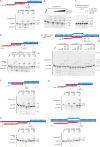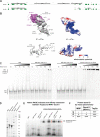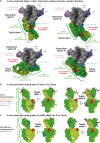The human RNA polymerase I structure reveals an HMG-like docking domain specific to metazoans
- PMID: 36271492
- PMCID: PMC9438803
- DOI: 10.26508/lsa.202201568
The human RNA polymerase I structure reveals an HMG-like docking domain specific to metazoans
Abstract
Transcription of the ribosomal RNA precursor by RNA polymerase (Pol) I is a major determinant of cellular growth, and dysregulation is observed in many cancer types. Here, we present the purification of human Pol I from cells carrying a genomic GFP fusion on the largest subunit allowing the structural and functional analysis of the enzyme across species. In contrast to yeast, human Pol I carries a single-subunit stalk, and in vitro transcription indicates a reduced proofreading activity. Determination of the human Pol I cryo-EM reconstruction in a close-to-native state rationalizes the effects of disease-associated mutations and uncovers an additional domain that is built into the sequence of Pol I subunit RPA1. This "dock II" domain resembles a truncated HMG box incapable of DNA binding which may serve as a downstream transcription factor-binding platform in metazoans. Biochemical analysis, in situ modelling, and ChIP data indicate that Topoisomerase 2a can be recruited to Pol I via the domain and cooperates with the HMG box domain-containing factor UBF. These adaptations of the metazoan Pol I transcription system may allow efficient release of positive DNA supercoils accumulating downstream of the transcription bubble.
© 2022 Daiß et al.
Conflict of interest statement
The authors declare that they have no conflict of interest.
Figures
















References
-
- Falcon KT, Watt KEN, Dash S, Zhao R, Sakai D, Moore EL, Fitriasari S, Childers M, Sardiu ME, Swanson S, et al. (2022). Dynamic regulation and requirement for ribosomal RNA transcription during mammalian development. Proc Natl Acad Sci U S A 119: e2116974119. 10.1073/pnas.2116974119 - DOI - PMC - PubMed
Publication types
MeSH terms
Substances
Associated data
- Actions
- Actions
- Actions
- Actions
- Actions
- Actions
- Actions
- Actions
- Actions
- Actions
- Actions
- Actions
LinkOut - more resources
Full Text Sources
Molecular Biology Databases
